Sustainability Report for Timberwell Construction: GRI Standards Analysis
VerifiedAdded on 2023/06/08
|13
|3780
|419
AI Summary
This report analyses a case study regarding Timberwell construction for reporting their sustainable business practice maintaining GRI standards. The future oriented technique reporting as stated in GRI guidelines is a body of principles which are meant to be observed. A company’s inability to obey the sustainability conditions is regarded as serious violation which diminishes market value of a certain organisation. Discussing basic theories of GRI standards and why the sustainability issue has become so significance in contemporary era, this report has highlighted three dimensions of sustainability; economic, environmental and social standards.
Contribute Materials
Your contribution can guide someone’s learning journey. Share your
documents today.
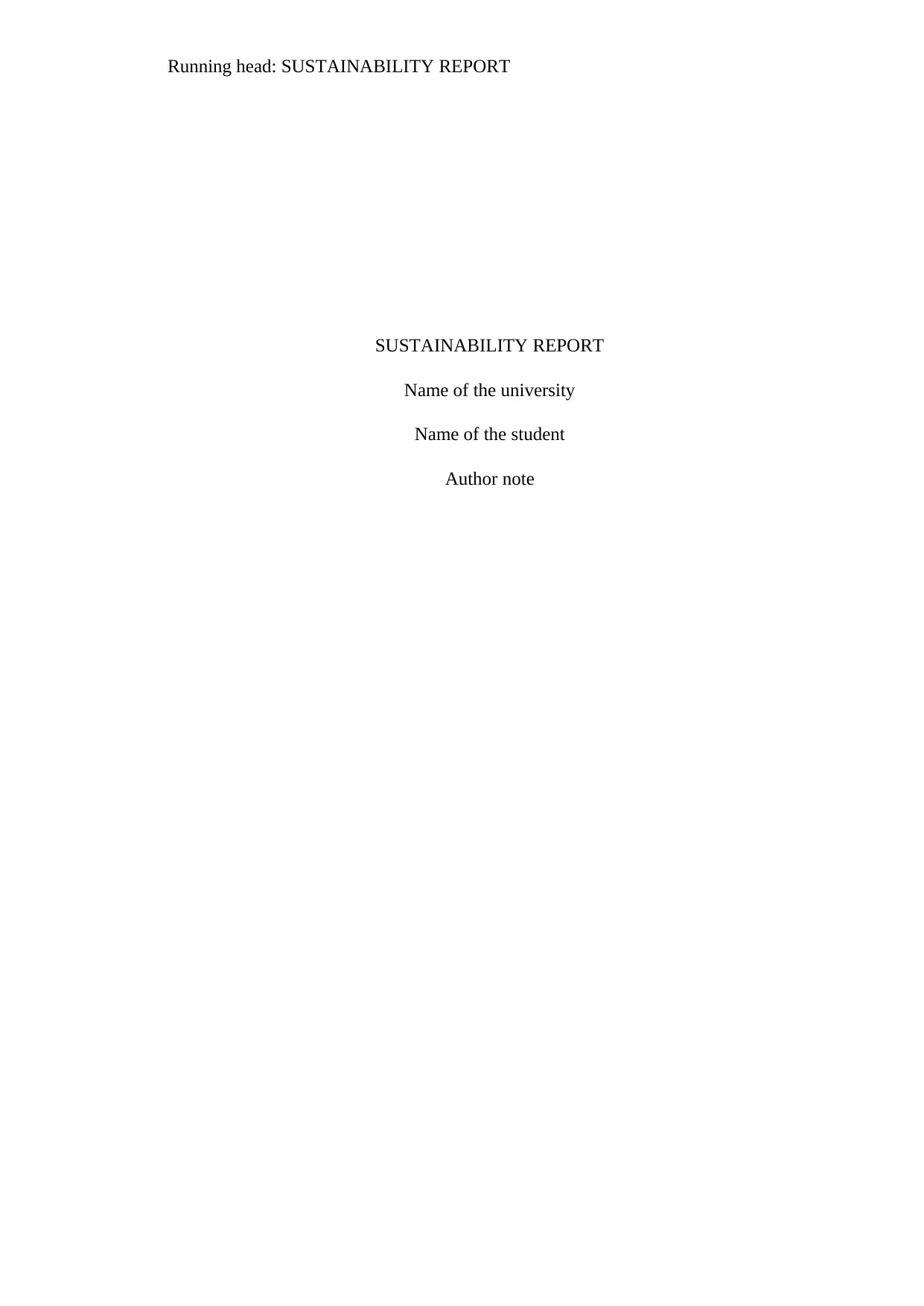
Running head: SUSTAINABILITY REPORT
SUSTAINABILITY REPORT
Name of the university
Name of the student
Author note
SUSTAINABILITY REPORT
Name of the university
Name of the student
Author note
Secure Best Marks with AI Grader
Need help grading? Try our AI Grader for instant feedback on your assignments.
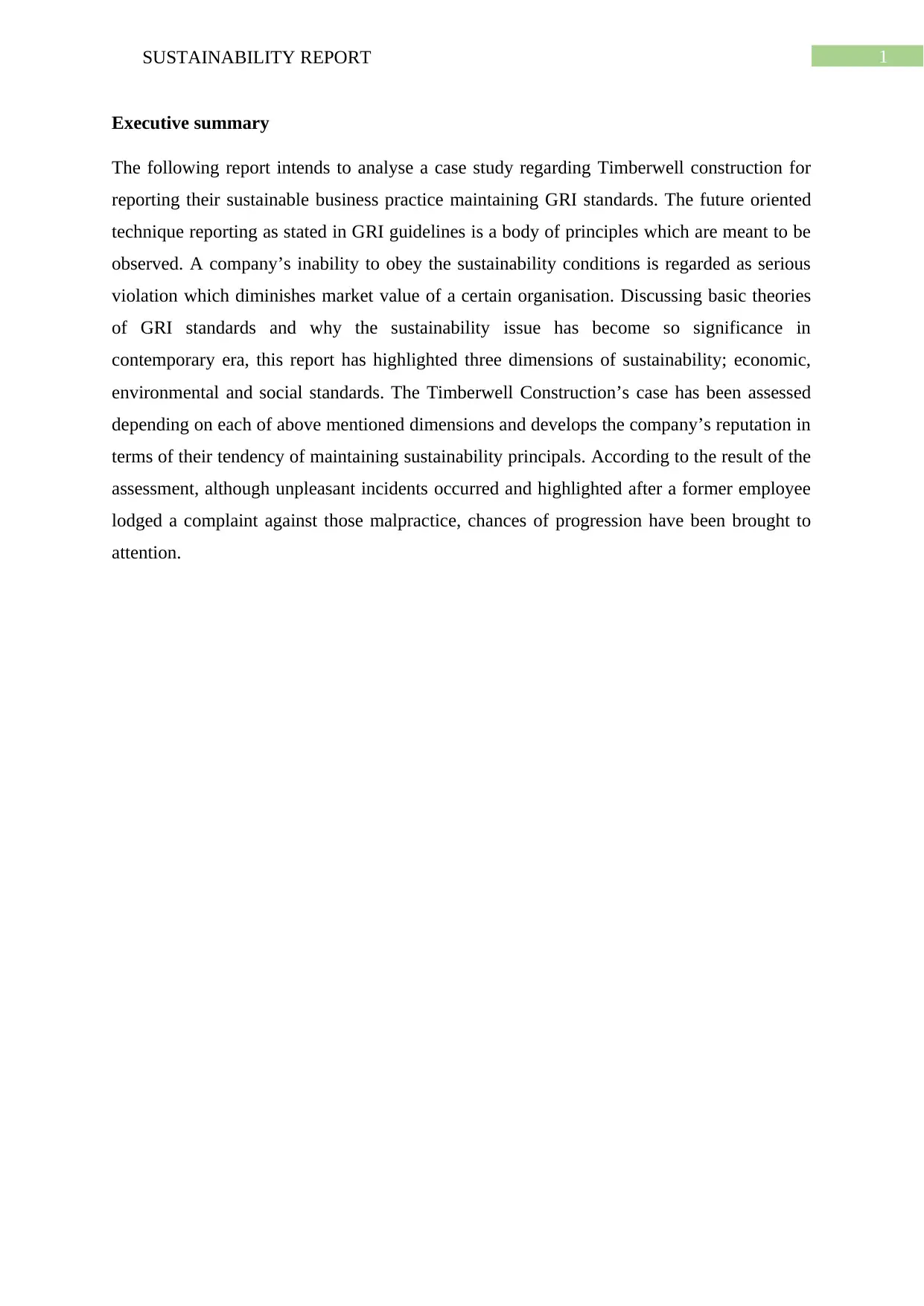
1SUSTAINABILITY REPORT
Executive summary
The following report intends to analyse a case study regarding Timberwell construction for
reporting their sustainable business practice maintaining GRI standards. The future oriented
technique reporting as stated in GRI guidelines is a body of principles which are meant to be
observed. A company’s inability to obey the sustainability conditions is regarded as serious
violation which diminishes market value of a certain organisation. Discussing basic theories
of GRI standards and why the sustainability issue has become so significance in
contemporary era, this report has highlighted three dimensions of sustainability; economic,
environmental and social standards. The Timberwell Construction’s case has been assessed
depending on each of above mentioned dimensions and develops the company’s reputation in
terms of their tendency of maintaining sustainability principals. According to the result of the
assessment, although unpleasant incidents occurred and highlighted after a former employee
lodged a complaint against those malpractice, chances of progression have been brought to
attention.
Executive summary
The following report intends to analyse a case study regarding Timberwell construction for
reporting their sustainable business practice maintaining GRI standards. The future oriented
technique reporting as stated in GRI guidelines is a body of principles which are meant to be
observed. A company’s inability to obey the sustainability conditions is regarded as serious
violation which diminishes market value of a certain organisation. Discussing basic theories
of GRI standards and why the sustainability issue has become so significance in
contemporary era, this report has highlighted three dimensions of sustainability; economic,
environmental and social standards. The Timberwell Construction’s case has been assessed
depending on each of above mentioned dimensions and develops the company’s reputation in
terms of their tendency of maintaining sustainability principals. According to the result of the
assessment, although unpleasant incidents occurred and highlighted after a former employee
lodged a complaint against those malpractice, chances of progression have been brought to
attention.

2SUSTAINABILITY REPORT
Table of Contents
Introduction....................................................................................................................3
Background................................................................................................................3
Methodology..............................................................................................................3
Economic sustainability.................................................................................................4
Disclosure 201-2........................................................................................................4
Disclosure 205-3........................................................................................................5
Disclosure 206-1........................................................................................................5
Environmental Sustainability.........................................................................................5
Disclosure 302-1........................................................................................................6
Disclosure 304-2........................................................................................................7
Disclosure 307-1........................................................................................................7
Social sustainability.......................................................................................................7
Disclosure 401-1........................................................................................................8
Disclosure 406-1........................................................................................................8
Disclosure 413-1........................................................................................................9
Conclusion......................................................................................................................9
References....................................................................................................................11
Table of Contents
Introduction....................................................................................................................3
Background................................................................................................................3
Methodology..............................................................................................................3
Economic sustainability.................................................................................................4
Disclosure 201-2........................................................................................................4
Disclosure 205-3........................................................................................................5
Disclosure 206-1........................................................................................................5
Environmental Sustainability.........................................................................................5
Disclosure 302-1........................................................................................................6
Disclosure 304-2........................................................................................................7
Disclosure 307-1........................................................................................................7
Social sustainability.......................................................................................................7
Disclosure 401-1........................................................................................................8
Disclosure 406-1........................................................................................................8
Disclosure 413-1........................................................................................................9
Conclusion......................................................................................................................9
References....................................................................................................................11
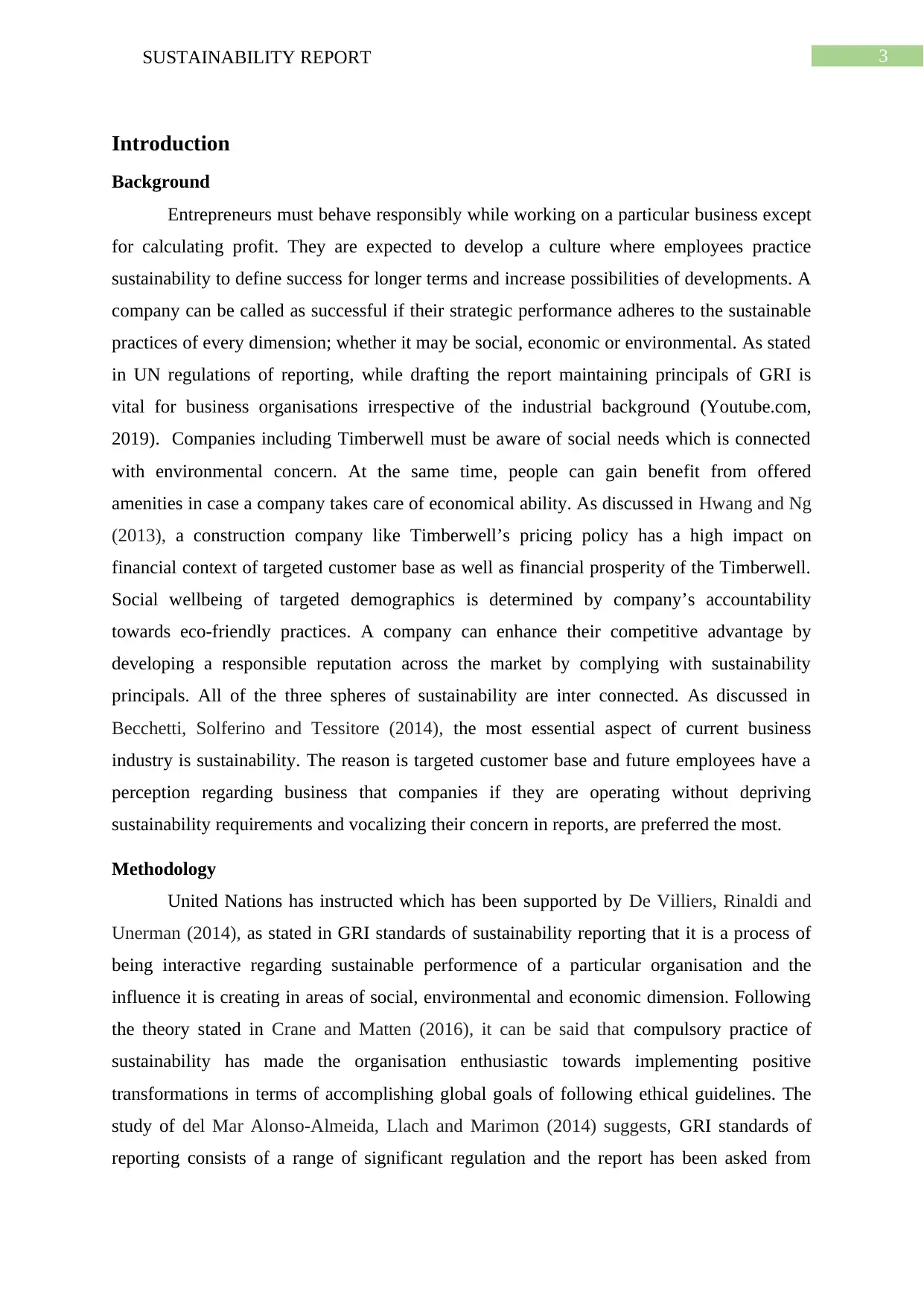
3SUSTAINABILITY REPORT
Introduction
Background
Entrepreneurs must behave responsibly while working on a particular business except
for calculating profit. They are expected to develop a culture where employees practice
sustainability to define success for longer terms and increase possibilities of developments. A
company can be called as successful if their strategic performance adheres to the sustainable
practices of every dimension; whether it may be social, economic or environmental. As stated
in UN regulations of reporting, while drafting the report maintaining principals of GRI is
vital for business organisations irrespective of the industrial background (Youtube.com,
2019). Companies including Timberwell must be aware of social needs which is connected
with environmental concern. At the same time, people can gain benefit from offered
amenities in case a company takes care of economical ability. As discussed in Hwang and Ng
(2013), a construction company like Timberwell’s pricing policy has a high impact on
financial context of targeted customer base as well as financial prosperity of the Timberwell.
Social wellbeing of targeted demographics is determined by company’s accountability
towards eco-friendly practices. A company can enhance their competitive advantage by
developing a responsible reputation across the market by complying with sustainability
principals. All of the three spheres of sustainability are inter connected. As discussed in
Becchetti, Solferino and Tessitore (2014), the most essential aspect of current business
industry is sustainability. The reason is targeted customer base and future employees have a
perception regarding business that companies if they are operating without depriving
sustainability requirements and vocalizing their concern in reports, are preferred the most.
Methodology
United Nations has instructed which has been supported by De Villiers, Rinaldi and
Unerman (2014), as stated in GRI standards of sustainability reporting that it is a process of
being interactive regarding sustainable performence of a particular organisation and the
influence it is creating in areas of social, environmental and economic dimension. Following
the theory stated in Crane and Matten (2016), it can be said that compulsory practice of
sustainability has made the organisation enthusiastic towards implementing positive
transformations in terms of accomplishing global goals of following ethical guidelines. The
study of del Mar Alonso‐Almeida, Llach and Marimon (2014) suggests, GRI standards of
reporting consists of a range of significant regulation and the report has been asked from
Introduction
Background
Entrepreneurs must behave responsibly while working on a particular business except
for calculating profit. They are expected to develop a culture where employees practice
sustainability to define success for longer terms and increase possibilities of developments. A
company can be called as successful if their strategic performance adheres to the sustainable
practices of every dimension; whether it may be social, economic or environmental. As stated
in UN regulations of reporting, while drafting the report maintaining principals of GRI is
vital for business organisations irrespective of the industrial background (Youtube.com,
2019). Companies including Timberwell must be aware of social needs which is connected
with environmental concern. At the same time, people can gain benefit from offered
amenities in case a company takes care of economical ability. As discussed in Hwang and Ng
(2013), a construction company like Timberwell’s pricing policy has a high impact on
financial context of targeted customer base as well as financial prosperity of the Timberwell.
Social wellbeing of targeted demographics is determined by company’s accountability
towards eco-friendly practices. A company can enhance their competitive advantage by
developing a responsible reputation across the market by complying with sustainability
principals. All of the three spheres of sustainability are inter connected. As discussed in
Becchetti, Solferino and Tessitore (2014), the most essential aspect of current business
industry is sustainability. The reason is targeted customer base and future employees have a
perception regarding business that companies if they are operating without depriving
sustainability requirements and vocalizing their concern in reports, are preferred the most.
Methodology
United Nations has instructed which has been supported by De Villiers, Rinaldi and
Unerman (2014), as stated in GRI standards of sustainability reporting that it is a process of
being interactive regarding sustainable performence of a particular organisation and the
influence it is creating in areas of social, environmental and economic dimension. Following
the theory stated in Crane and Matten (2016), it can be said that compulsory practice of
sustainability has made the organisation enthusiastic towards implementing positive
transformations in terms of accomplishing global goals of following ethical guidelines. The
study of del Mar Alonso‐Almeida, Llach and Marimon (2014) suggests, GRI standards of
reporting consists of a range of significant regulation and the report has been asked from
Secure Best Marks with AI Grader
Need help grading? Try our AI Grader for instant feedback on your assignments.

4SUSTAINABILITY REPORT
companies to prove, through a detail clarification, their answerability towards specific
regulations which would confirm their accomplishment of global objective of sustainable
development. A detail observation of (Youtube.com, 2019), helps to recognize the
forthcoming era of sustainability reporting practices. This report will innovate various sights
of sustainability keeping case of Timberwell Constructions at the centre.
Economic sustainability
Long term growth procedure of certain organisation is dependable on economic
sustainability of a certain organisation exploiting existing resources in a way that adds value
to the offered product or service along with that, it assists them to set a reasonable pricing for
consumers and suppliers as well. It encourages sustainable procedure of using resources for
managing both the human and monetary possessions. According to MILNE, Gray and BUHR
(2014), it results in creating value for longer term to the organisational service and product by
providing the service that satisfies requirement of society without wasting or using excessive
amount of resources. An organisation can be socially responsible if they are operating
business following smart economical policies. Organisation can progress and maintain
gradual growth following cost effective ideas.
Disclosure 201-2
Financial implications and other risks and opportunities due to climate change
Timberwell’s business going down as the company was suffering from immense
negative promotions as well as voluntary employee turnover due to their faulty business
practice in major operational areas of business. With the purpose of breaking negative
reputation and transforming stagnant culture into a mobilize one they applied strategies to
create an affirmative brand image, Timeberwell decided to opt for multiple media release to
elevate their position in construction market. As reinforced by Hahn and Kühnen (2013),
while reporting special attention business practices and its accountability towards sustainable
practices in each dimensions displayed progressive outcome. The first ever media release
emphasized how the company has conserved children parks along with greenery and abided
by environmental guidelines while erecting constructions. Following the guidelines of
Mohammad (2013), the second one proudly channelize their strategy in terms of maintaining
operations that are energy efficient. The company has attached evidence of their lower
exploitation of electricity, both the sources which are renewable and non-renewable too.
Third release was all about monetary investment for contributing in progression of local
companies to prove, through a detail clarification, their answerability towards specific
regulations which would confirm their accomplishment of global objective of sustainable
development. A detail observation of (Youtube.com, 2019), helps to recognize the
forthcoming era of sustainability reporting practices. This report will innovate various sights
of sustainability keeping case of Timberwell Constructions at the centre.
Economic sustainability
Long term growth procedure of certain organisation is dependable on economic
sustainability of a certain organisation exploiting existing resources in a way that adds value
to the offered product or service along with that, it assists them to set a reasonable pricing for
consumers and suppliers as well. It encourages sustainable procedure of using resources for
managing both the human and monetary possessions. According to MILNE, Gray and BUHR
(2014), it results in creating value for longer term to the organisational service and product by
providing the service that satisfies requirement of society without wasting or using excessive
amount of resources. An organisation can be socially responsible if they are operating
business following smart economical policies. Organisation can progress and maintain
gradual growth following cost effective ideas.
Disclosure 201-2
Financial implications and other risks and opportunities due to climate change
Timberwell’s business going down as the company was suffering from immense
negative promotions as well as voluntary employee turnover due to their faulty business
practice in major operational areas of business. With the purpose of breaking negative
reputation and transforming stagnant culture into a mobilize one they applied strategies to
create an affirmative brand image, Timeberwell decided to opt for multiple media release to
elevate their position in construction market. As reinforced by Hahn and Kühnen (2013),
while reporting special attention business practices and its accountability towards sustainable
practices in each dimensions displayed progressive outcome. The first ever media release
emphasized how the company has conserved children parks along with greenery and abided
by environmental guidelines while erecting constructions. Following the guidelines of
Mohammad (2013), the second one proudly channelize their strategy in terms of maintaining
operations that are energy efficient. The company has attached evidence of their lower
exploitation of electricity, both the sources which are renewable and non-renewable too.
Third release was all about monetary investment for contributing in progression of local
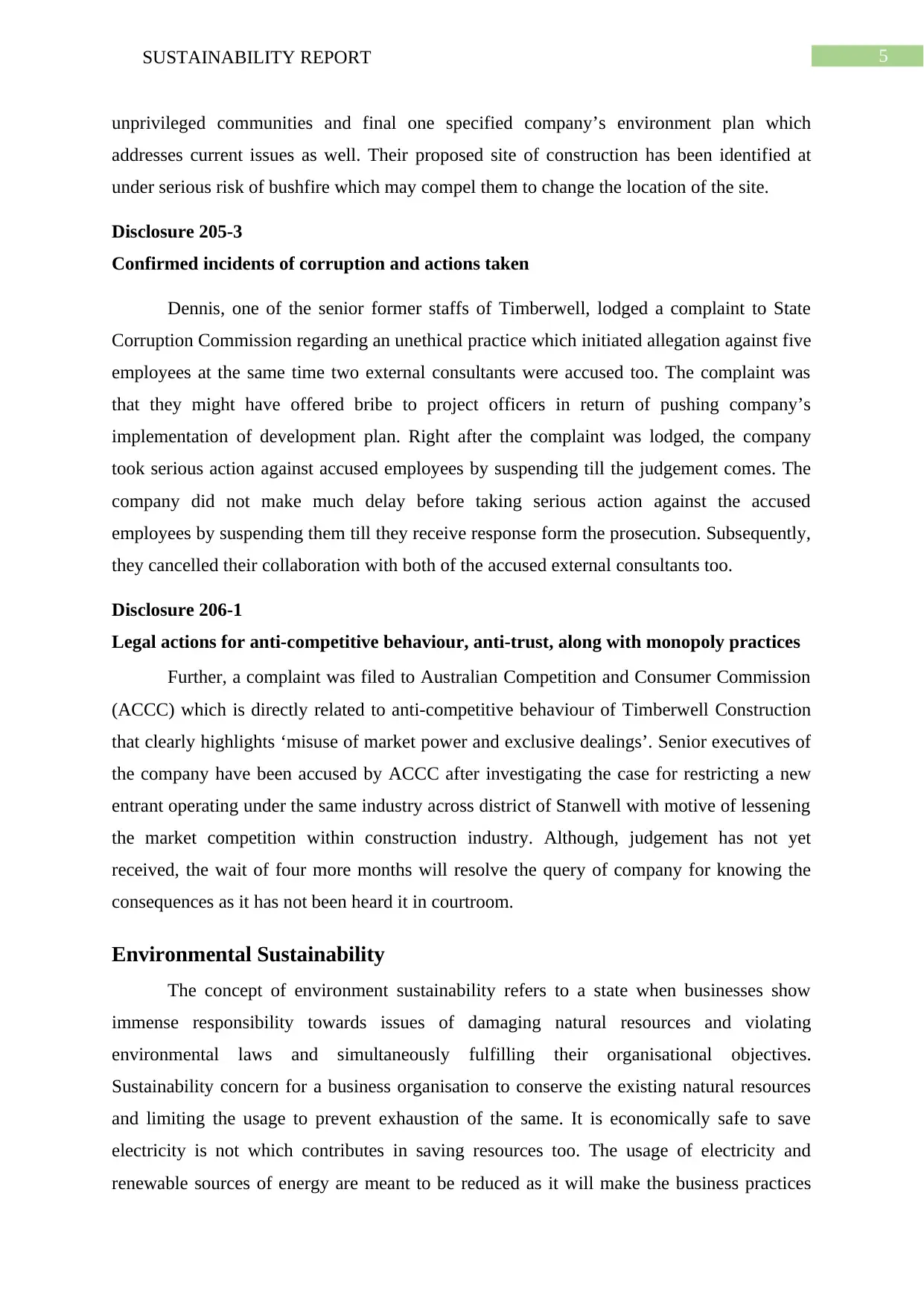
5SUSTAINABILITY REPORT
unprivileged communities and final one specified company’s environment plan which
addresses current issues as well. Their proposed site of construction has been identified at
under serious risk of bushfire which may compel them to change the location of the site.
Disclosure 205-3
Confirmed incidents of corruption and actions taken
Dennis, one of the senior former staffs of Timberwell, lodged a complaint to State
Corruption Commission regarding an unethical practice which initiated allegation against five
employees at the same time two external consultants were accused too. The complaint was
that they might have offered bribe to project officers in return of pushing company’s
implementation of development plan. Right after the complaint was lodged, the company
took serious action against accused employees by suspending till the judgement comes. The
company did not make much delay before taking serious action against the accused
employees by suspending them till they receive response form the prosecution. Subsequently,
they cancelled their collaboration with both of the accused external consultants too.
Disclosure 206-1
Legal actions for anti-competitive behaviour, anti-trust, along with monopoly practices
Further, a complaint was filed to Australian Competition and Consumer Commission
(ACCC) which is directly related to anti-competitive behaviour of Timberwell Construction
that clearly highlights ‘misuse of market power and exclusive dealings’. Senior executives of
the company have been accused by ACCC after investigating the case for restricting a new
entrant operating under the same industry across district of Stanwell with motive of lessening
the market competition within construction industry. Although, judgement has not yet
received, the wait of four more months will resolve the query of company for knowing the
consequences as it has not been heard it in courtroom.
Environmental Sustainability
The concept of environment sustainability refers to a state when businesses show
immense responsibility towards issues of damaging natural resources and violating
environmental laws and simultaneously fulfilling their organisational objectives.
Sustainability concern for a business organisation to conserve the existing natural resources
and limiting the usage to prevent exhaustion of the same. It is economically safe to save
electricity is not which contributes in saving resources too. The usage of electricity and
renewable sources of energy are meant to be reduced as it will make the business practices
unprivileged communities and final one specified company’s environment plan which
addresses current issues as well. Their proposed site of construction has been identified at
under serious risk of bushfire which may compel them to change the location of the site.
Disclosure 205-3
Confirmed incidents of corruption and actions taken
Dennis, one of the senior former staffs of Timberwell, lodged a complaint to State
Corruption Commission regarding an unethical practice which initiated allegation against five
employees at the same time two external consultants were accused too. The complaint was
that they might have offered bribe to project officers in return of pushing company’s
implementation of development plan. Right after the complaint was lodged, the company
took serious action against accused employees by suspending till the judgement comes. The
company did not make much delay before taking serious action against the accused
employees by suspending them till they receive response form the prosecution. Subsequently,
they cancelled their collaboration with both of the accused external consultants too.
Disclosure 206-1
Legal actions for anti-competitive behaviour, anti-trust, along with monopoly practices
Further, a complaint was filed to Australian Competition and Consumer Commission
(ACCC) which is directly related to anti-competitive behaviour of Timberwell Construction
that clearly highlights ‘misuse of market power and exclusive dealings’. Senior executives of
the company have been accused by ACCC after investigating the case for restricting a new
entrant operating under the same industry across district of Stanwell with motive of lessening
the market competition within construction industry. Although, judgement has not yet
received, the wait of four more months will resolve the query of company for knowing the
consequences as it has not been heard it in courtroom.
Environmental Sustainability
The concept of environment sustainability refers to a state when businesses show
immense responsibility towards issues of damaging natural resources and violating
environmental laws and simultaneously fulfilling their organisational objectives.
Sustainability concern for a business organisation to conserve the existing natural resources
and limiting the usage to prevent exhaustion of the same. It is economically safe to save
electricity is not which contributes in saving resources too. The usage of electricity and
renewable sources of energy are meant to be reduced as it will make the business practices
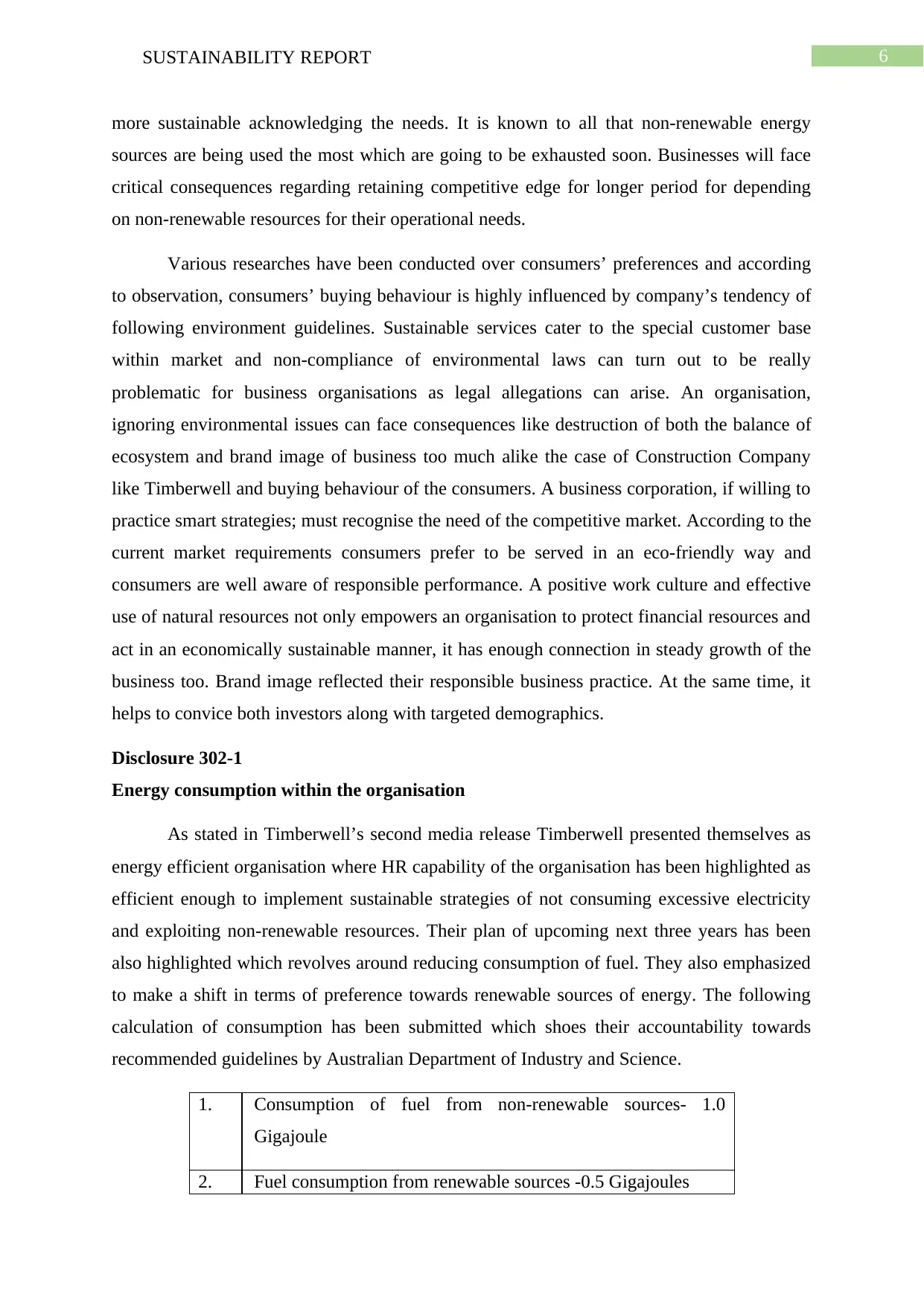
6SUSTAINABILITY REPORT
more sustainable acknowledging the needs. It is known to all that non-renewable energy
sources are being used the most which are going to be exhausted soon. Businesses will face
critical consequences regarding retaining competitive edge for longer period for depending
on non-renewable resources for their operational needs.
Various researches have been conducted over consumers’ preferences and according
to observation, consumers’ buying behaviour is highly influenced by company’s tendency of
following environment guidelines. Sustainable services cater to the special customer base
within market and non-compliance of environmental laws can turn out to be really
problematic for business organisations as legal allegations can arise. An organisation,
ignoring environmental issues can face consequences like destruction of both the balance of
ecosystem and brand image of business too much alike the case of Construction Company
like Timberwell and buying behaviour of the consumers. A business corporation, if willing to
practice smart strategies; must recognise the need of the competitive market. According to the
current market requirements consumers prefer to be served in an eco-friendly way and
consumers are well aware of responsible performance. A positive work culture and effective
use of natural resources not only empowers an organisation to protect financial resources and
act in an economically sustainable manner, it has enough connection in steady growth of the
business too. Brand image reflected their responsible business practice. At the same time, it
helps to convice both investors along with targeted demographics.
Disclosure 302-1
Energy consumption within the organisation
As stated in Timberwell’s second media release Timberwell presented themselves as
energy efficient organisation where HR capability of the organisation has been highlighted as
efficient enough to implement sustainable strategies of not consuming excessive electricity
and exploiting non-renewable resources. Their plan of upcoming next three years has been
also highlighted which revolves around reducing consumption of fuel. They also emphasized
to make a shift in terms of preference towards renewable sources of energy. The following
calculation of consumption has been submitted which shoes their accountability towards
recommended guidelines by Australian Department of Industry and Science.
1. Consumption of fuel from non-renewable sources- 1.0
Gigajoule
2. Fuel consumption from renewable sources -0.5 Gigajoules
more sustainable acknowledging the needs. It is known to all that non-renewable energy
sources are being used the most which are going to be exhausted soon. Businesses will face
critical consequences regarding retaining competitive edge for longer period for depending
on non-renewable resources for their operational needs.
Various researches have been conducted over consumers’ preferences and according
to observation, consumers’ buying behaviour is highly influenced by company’s tendency of
following environment guidelines. Sustainable services cater to the special customer base
within market and non-compliance of environmental laws can turn out to be really
problematic for business organisations as legal allegations can arise. An organisation,
ignoring environmental issues can face consequences like destruction of both the balance of
ecosystem and brand image of business too much alike the case of Construction Company
like Timberwell and buying behaviour of the consumers. A business corporation, if willing to
practice smart strategies; must recognise the need of the competitive market. According to the
current market requirements consumers prefer to be served in an eco-friendly way and
consumers are well aware of responsible performance. A positive work culture and effective
use of natural resources not only empowers an organisation to protect financial resources and
act in an economically sustainable manner, it has enough connection in steady growth of the
business too. Brand image reflected their responsible business practice. At the same time, it
helps to convice both investors along with targeted demographics.
Disclosure 302-1
Energy consumption within the organisation
As stated in Timberwell’s second media release Timberwell presented themselves as
energy efficient organisation where HR capability of the organisation has been highlighted as
efficient enough to implement sustainable strategies of not consuming excessive electricity
and exploiting non-renewable resources. Their plan of upcoming next three years has been
also highlighted which revolves around reducing consumption of fuel. They also emphasized
to make a shift in terms of preference towards renewable sources of energy. The following
calculation of consumption has been submitted which shoes their accountability towards
recommended guidelines by Australian Department of Industry and Science.
1. Consumption of fuel from non-renewable sources- 1.0
Gigajoule
2. Fuel consumption from renewable sources -0.5 Gigajoules
Paraphrase This Document
Need a fresh take? Get an instant paraphrase of this document with our AI Paraphraser
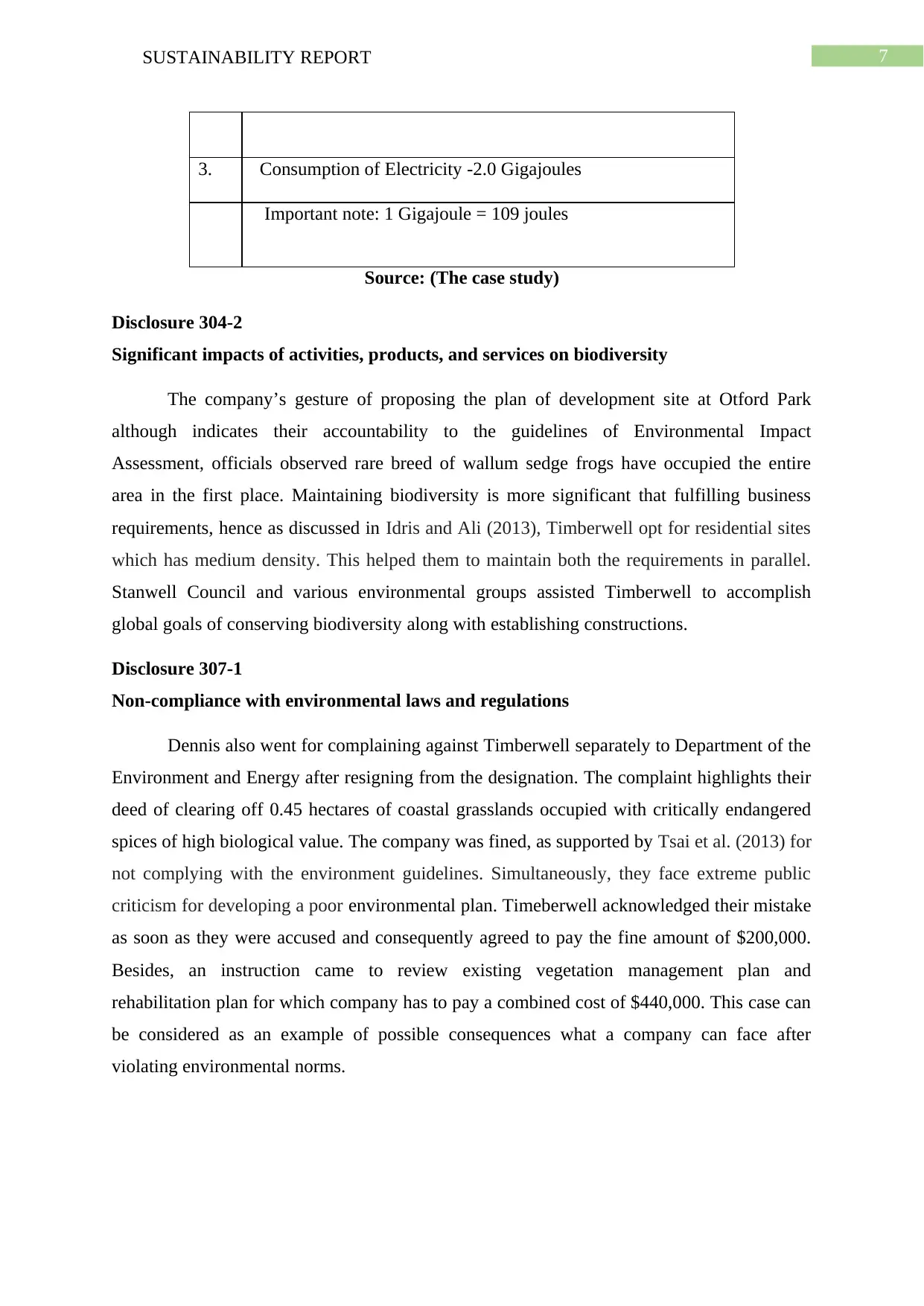
7SUSTAINABILITY REPORT
3. Consumption of Electricity -2.0 Gigajoules
Important note: 1 Gigajoule = 109 joules
Source: (The case study)
Disclosure 304-2
Significant impacts of activities, products, and services on biodiversity
The company’s gesture of proposing the plan of development site at Otford Park
although indicates their accountability to the guidelines of Environmental Impact
Assessment, officials observed rare breed of wallum sedge frogs have occupied the entire
area in the first place. Maintaining biodiversity is more significant that fulfilling business
requirements, hence as discussed in Idris and Ali (2013), Timberwell opt for residential sites
which has medium density. This helped them to maintain both the requirements in parallel.
Stanwell Council and various environmental groups assisted Timberwell to accomplish
global goals of conserving biodiversity along with establishing constructions.
Disclosure 307-1
Non-compliance with environmental laws and regulations
Dennis also went for complaining against Timberwell separately to Department of the
Environment and Energy after resigning from the designation. The complaint highlights their
deed of clearing off 0.45 hectares of coastal grasslands occupied with critically endangered
spices of high biological value. The company was fined, as supported by Tsai et al. (2013) for
not complying with the environment guidelines. Simultaneously, they face extreme public
criticism for developing a poor environmental plan. Timeberwell acknowledged their mistake
as soon as they were accused and consequently agreed to pay the fine amount of $200,000.
Besides, an instruction came to review existing vegetation management plan and
rehabilitation plan for which company has to pay a combined cost of $440,000. This case can
be considered as an example of possible consequences what a company can face after
violating environmental norms.
3. Consumption of Electricity -2.0 Gigajoules
Important note: 1 Gigajoule = 109 joules
Source: (The case study)
Disclosure 304-2
Significant impacts of activities, products, and services on biodiversity
The company’s gesture of proposing the plan of development site at Otford Park
although indicates their accountability to the guidelines of Environmental Impact
Assessment, officials observed rare breed of wallum sedge frogs have occupied the entire
area in the first place. Maintaining biodiversity is more significant that fulfilling business
requirements, hence as discussed in Idris and Ali (2013), Timberwell opt for residential sites
which has medium density. This helped them to maintain both the requirements in parallel.
Stanwell Council and various environmental groups assisted Timberwell to accomplish
global goals of conserving biodiversity along with establishing constructions.
Disclosure 307-1
Non-compliance with environmental laws and regulations
Dennis also went for complaining against Timberwell separately to Department of the
Environment and Energy after resigning from the designation. The complaint highlights their
deed of clearing off 0.45 hectares of coastal grasslands occupied with critically endangered
spices of high biological value. The company was fined, as supported by Tsai et al. (2013) for
not complying with the environment guidelines. Simultaneously, they face extreme public
criticism for developing a poor environmental plan. Timeberwell acknowledged their mistake
as soon as they were accused and consequently agreed to pay the fine amount of $200,000.
Besides, an instruction came to review existing vegetation management plan and
rehabilitation plan for which company has to pay a combined cost of $440,000. This case can
be considered as an example of possible consequences what a company can face after
violating environmental norms.

8SUSTAINABILITY REPORT
Social sustainability
Social sustainable practices offer wellbeing to the society. A company can achieve
social sustainability by satisfying the demand of customers’ professional and personal needs.
As stated in Lu and Zhang (2016), large organisations which face high employee turnover has
a tendency to avoid social sustainability guidelines. Lack of strong CSR policies also one of
the reasons of employee turnover. It belongs to organisation’s responsibility to ensure an
employee’s mental and physical health. At the same time, it must cure any of the society’s
major issue to create a positive impact (Walker et al. 2014). An employee’s good
performance depends on intensity of social support which reflects the organisational practice.
Besides, maintenance of friendly relationship with the stakeholders helps to enhance the
reputation in front of potential investors too. As directed by UN, global goals highly
influence the business quality and how things are being operated. Companies, well aware of
social responsibilities, has a tendency to evaluate their practice often through collecting
feedback from employees, consumers and citizens too. In case the regulations of human
rights, fair work commission, wellbeing, anti-discrimination and work life balance is
disturbed through malpractice of an organisation then social issues are identified widely.
Hence, it can be stated that sustainable practice is helpful in mitigating risks and preventing
them to occur frequently. Gradually it improves workplace culture, brand image and
employees will become reluctant to leave the organisation often. Besides, such responsible
behaviour, as stated in Rohrbeck, Konnertz and Knab (2013), consumers feel satisfied and
prospects of partnership and collaboration increased as investors show more interest.
Disclosure 401-1
New employee hires and employee turnover
The construction market of Stanwell council district is highly competitive and
acknowledging the scenario Timberwell had to appoint 58 male stuffs and 12 novice
apprentices in the first place. Investment into recruitment was high for higher employee
turnover and most importantly those are mostly voluntary. At that time, approximately, 17
employees left Timberwell for better opportunities in rival companies and less likely to
resolve personal issues. In order to restrict the rate of turnover and retain existing talents, the
organisation announced revised HR policies comprising of new increased salary and fixed
day off. It clearly has highlighted unprofessional handling of social responsibilities which
comes under control after their acknowledgement and hasty actions.
Social sustainability
Social sustainable practices offer wellbeing to the society. A company can achieve
social sustainability by satisfying the demand of customers’ professional and personal needs.
As stated in Lu and Zhang (2016), large organisations which face high employee turnover has
a tendency to avoid social sustainability guidelines. Lack of strong CSR policies also one of
the reasons of employee turnover. It belongs to organisation’s responsibility to ensure an
employee’s mental and physical health. At the same time, it must cure any of the society’s
major issue to create a positive impact (Walker et al. 2014). An employee’s good
performance depends on intensity of social support which reflects the organisational practice.
Besides, maintenance of friendly relationship with the stakeholders helps to enhance the
reputation in front of potential investors too. As directed by UN, global goals highly
influence the business quality and how things are being operated. Companies, well aware of
social responsibilities, has a tendency to evaluate their practice often through collecting
feedback from employees, consumers and citizens too. In case the regulations of human
rights, fair work commission, wellbeing, anti-discrimination and work life balance is
disturbed through malpractice of an organisation then social issues are identified widely.
Hence, it can be stated that sustainable practice is helpful in mitigating risks and preventing
them to occur frequently. Gradually it improves workplace culture, brand image and
employees will become reluctant to leave the organisation often. Besides, such responsible
behaviour, as stated in Rohrbeck, Konnertz and Knab (2013), consumers feel satisfied and
prospects of partnership and collaboration increased as investors show more interest.
Disclosure 401-1
New employee hires and employee turnover
The construction market of Stanwell council district is highly competitive and
acknowledging the scenario Timberwell had to appoint 58 male stuffs and 12 novice
apprentices in the first place. Investment into recruitment was high for higher employee
turnover and most importantly those are mostly voluntary. At that time, approximately, 17
employees left Timberwell for better opportunities in rival companies and less likely to
resolve personal issues. In order to restrict the rate of turnover and retain existing talents, the
organisation announced revised HR policies comprising of new increased salary and fixed
day off. It clearly has highlighted unprofessional handling of social responsibilities which
comes under control after their acknowledgement and hasty actions.
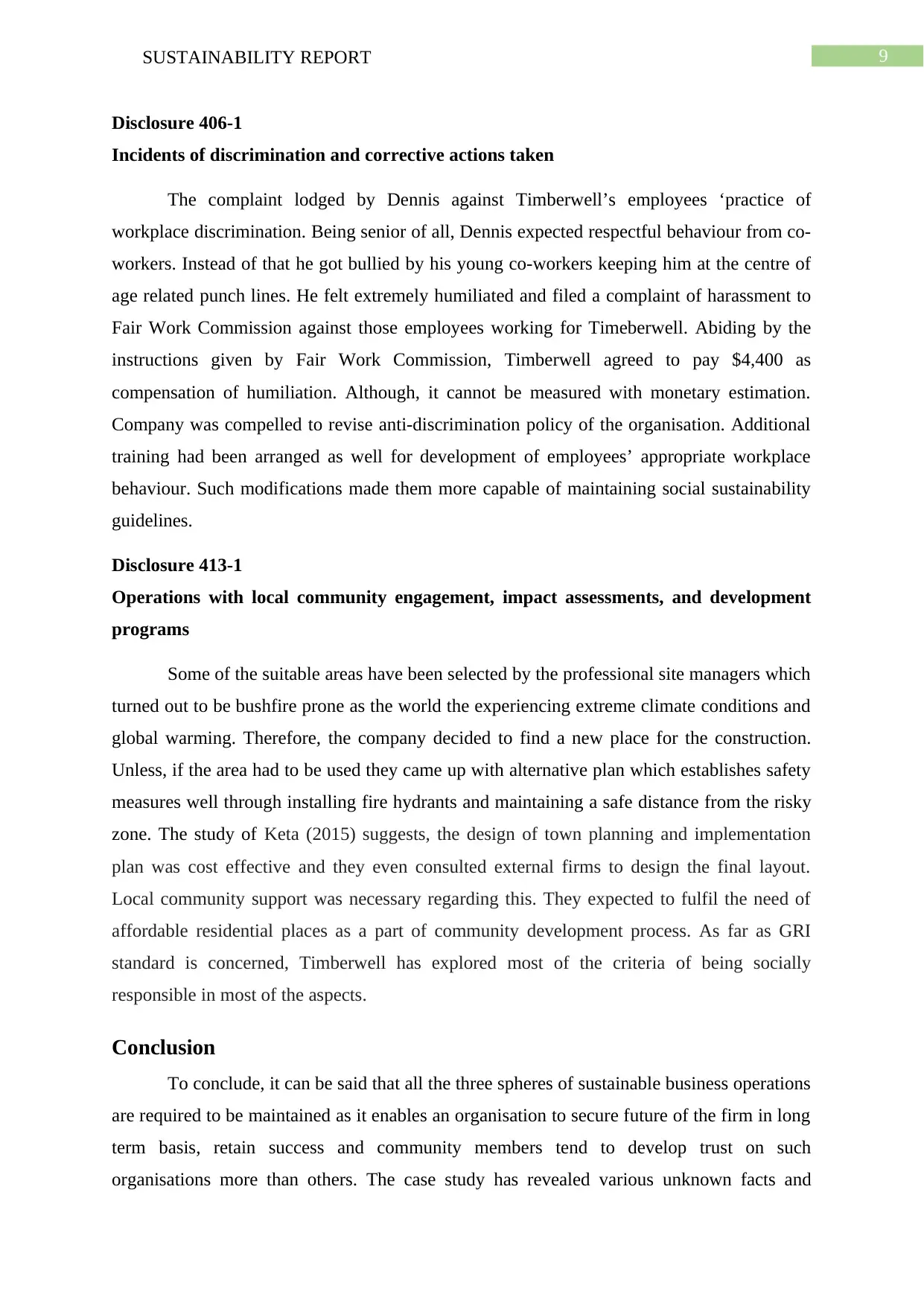
9SUSTAINABILITY REPORT
Disclosure 406-1
Incidents of discrimination and corrective actions taken
The complaint lodged by Dennis against Timberwell’s employees ‘practice of
workplace discrimination. Being senior of all, Dennis expected respectful behaviour from co-
workers. Instead of that he got bullied by his young co-workers keeping him at the centre of
age related punch lines. He felt extremely humiliated and filed a complaint of harassment to
Fair Work Commission against those employees working for Timeberwell. Abiding by the
instructions given by Fair Work Commission, Timberwell agreed to pay $4,400 as
compensation of humiliation. Although, it cannot be measured with monetary estimation.
Company was compelled to revise anti-discrimination policy of the organisation. Additional
training had been arranged as well for development of employees’ appropriate workplace
behaviour. Such modifications made them more capable of maintaining social sustainability
guidelines.
Disclosure 413-1
Operations with local community engagement, impact assessments, and development
programs
Some of the suitable areas have been selected by the professional site managers which
turned out to be bushfire prone as the world the experiencing extreme climate conditions and
global warming. Therefore, the company decided to find a new place for the construction.
Unless, if the area had to be used they came up with alternative plan which establishes safety
measures well through installing fire hydrants and maintaining a safe distance from the risky
zone. The study of Keta (2015) suggests, the design of town planning and implementation
plan was cost effective and they even consulted external firms to design the final layout.
Local community support was necessary regarding this. They expected to fulfil the need of
affordable residential places as a part of community development process. As far as GRI
standard is concerned, Timberwell has explored most of the criteria of being socially
responsible in most of the aspects.
Conclusion
To conclude, it can be said that all the three spheres of sustainable business operations
are required to be maintained as it enables an organisation to secure future of the firm in long
term basis, retain success and community members tend to develop trust on such
organisations more than others. The case study has revealed various unknown facts and
Disclosure 406-1
Incidents of discrimination and corrective actions taken
The complaint lodged by Dennis against Timberwell’s employees ‘practice of
workplace discrimination. Being senior of all, Dennis expected respectful behaviour from co-
workers. Instead of that he got bullied by his young co-workers keeping him at the centre of
age related punch lines. He felt extremely humiliated and filed a complaint of harassment to
Fair Work Commission against those employees working for Timeberwell. Abiding by the
instructions given by Fair Work Commission, Timberwell agreed to pay $4,400 as
compensation of humiliation. Although, it cannot be measured with monetary estimation.
Company was compelled to revise anti-discrimination policy of the organisation. Additional
training had been arranged as well for development of employees’ appropriate workplace
behaviour. Such modifications made them more capable of maintaining social sustainability
guidelines.
Disclosure 413-1
Operations with local community engagement, impact assessments, and development
programs
Some of the suitable areas have been selected by the professional site managers which
turned out to be bushfire prone as the world the experiencing extreme climate conditions and
global warming. Therefore, the company decided to find a new place for the construction.
Unless, if the area had to be used they came up with alternative plan which establishes safety
measures well through installing fire hydrants and maintaining a safe distance from the risky
zone. The study of Keta (2015) suggests, the design of town planning and implementation
plan was cost effective and they even consulted external firms to design the final layout.
Local community support was necessary regarding this. They expected to fulfil the need of
affordable residential places as a part of community development process. As far as GRI
standard is concerned, Timberwell has explored most of the criteria of being socially
responsible in most of the aspects.
Conclusion
To conclude, it can be said that all the three spheres of sustainable business operations
are required to be maintained as it enables an organisation to secure future of the firm in long
term basis, retain success and community members tend to develop trust on such
organisations more than others. The case study has revealed various unknown facts and
Secure Best Marks with AI Grader
Need help grading? Try our AI Grader for instant feedback on your assignments.
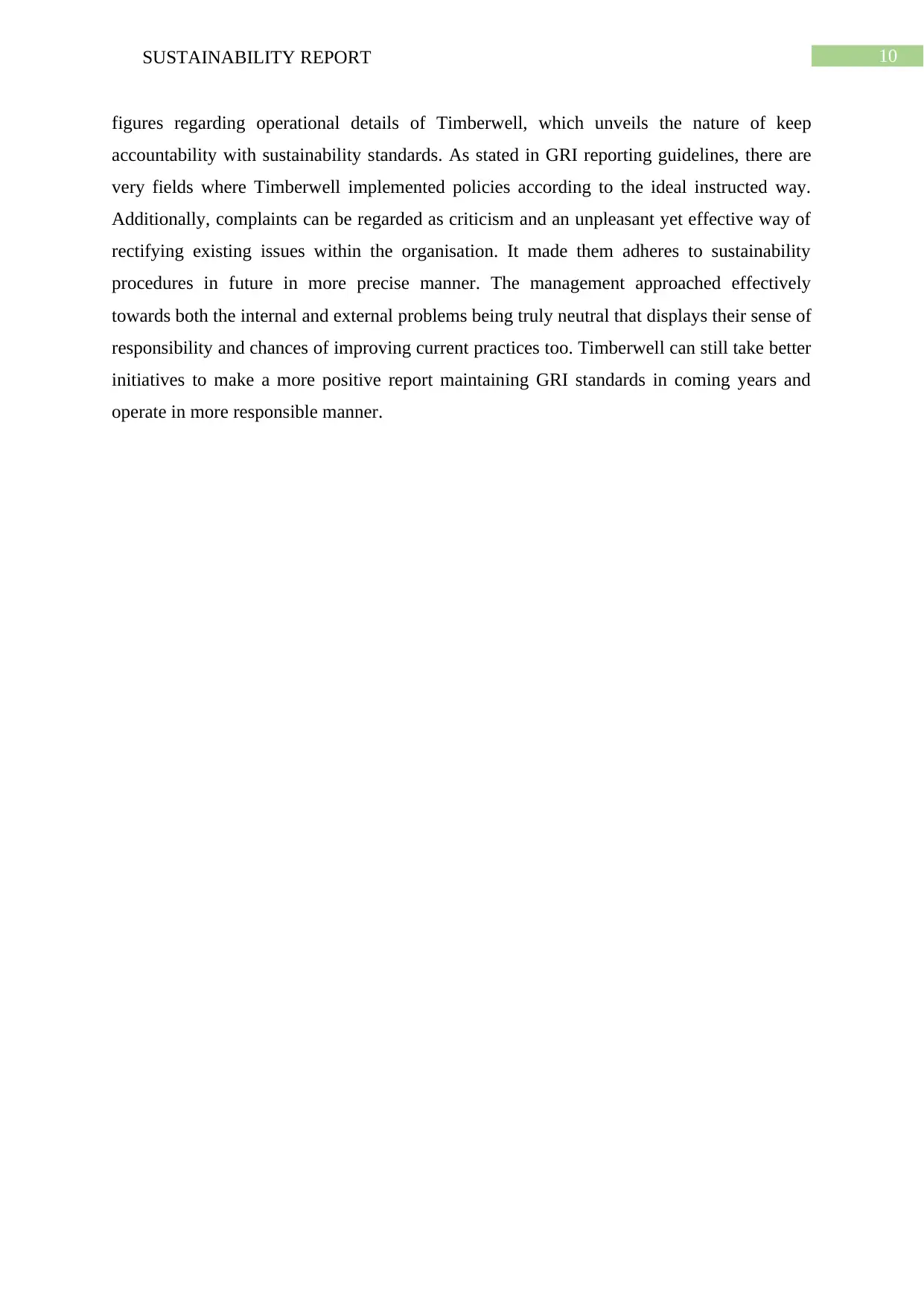
10SUSTAINABILITY REPORT
figures regarding operational details of Timberwell, which unveils the nature of keep
accountability with sustainability standards. As stated in GRI reporting guidelines, there are
very fields where Timberwell implemented policies according to the ideal instructed way.
Additionally, complaints can be regarded as criticism and an unpleasant yet effective way of
rectifying existing issues within the organisation. It made them adheres to sustainability
procedures in future in more precise manner. The management approached effectively
towards both the internal and external problems being truly neutral that displays their sense of
responsibility and chances of improving current practices too. Timberwell can still take better
initiatives to make a more positive report maintaining GRI standards in coming years and
operate in more responsible manner.
figures regarding operational details of Timberwell, which unveils the nature of keep
accountability with sustainability standards. As stated in GRI reporting guidelines, there are
very fields where Timberwell implemented policies according to the ideal instructed way.
Additionally, complaints can be regarded as criticism and an unpleasant yet effective way of
rectifying existing issues within the organisation. It made them adheres to sustainability
procedures in future in more precise manner. The management approached effectively
towards both the internal and external problems being truly neutral that displays their sense of
responsibility and chances of improving current practices too. Timberwell can still take better
initiatives to make a more positive report maintaining GRI standards in coming years and
operate in more responsible manner.
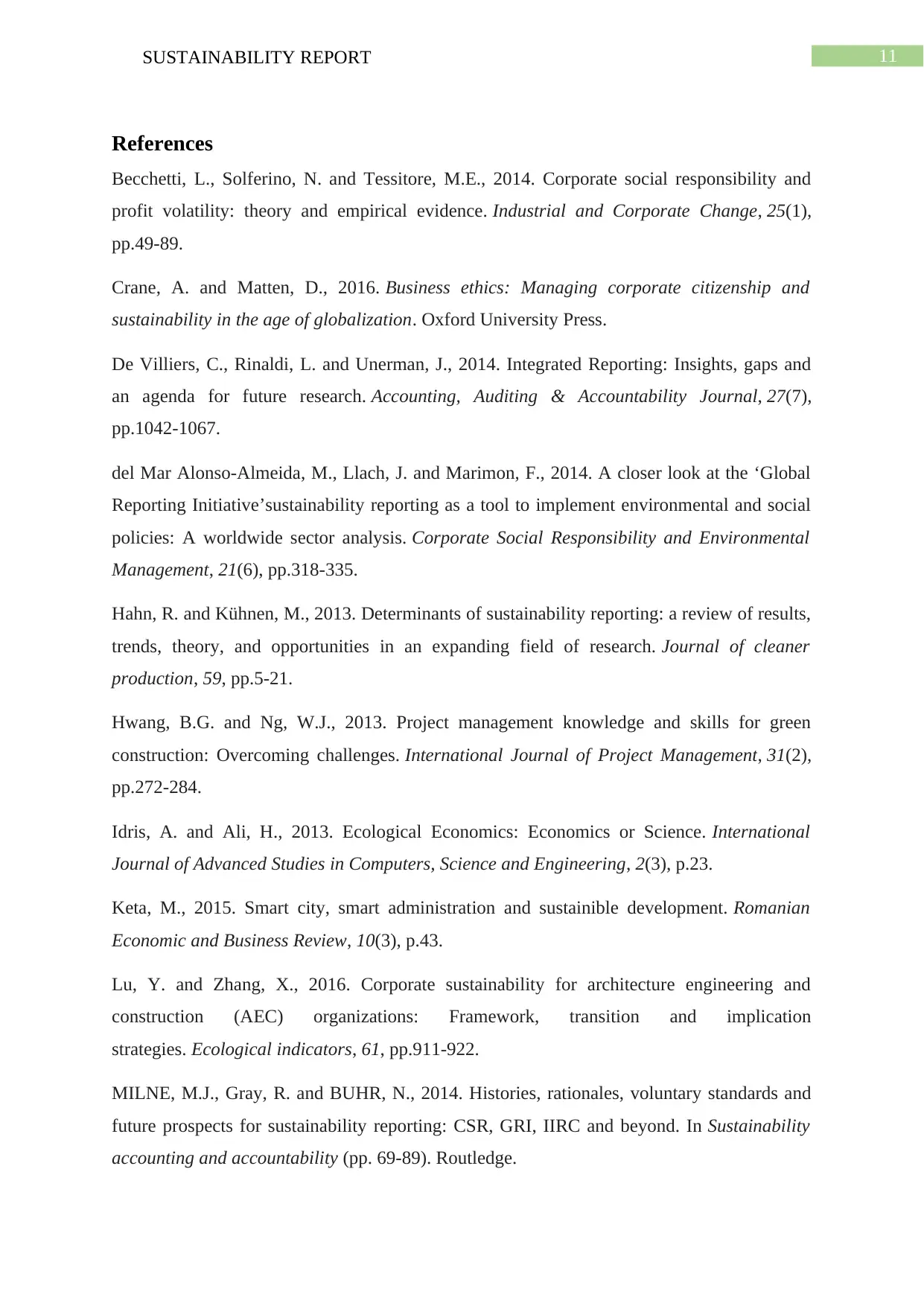
11SUSTAINABILITY REPORT
References
Becchetti, L., Solferino, N. and Tessitore, M.E., 2014. Corporate social responsibility and
profit volatility: theory and empirical evidence. Industrial and Corporate Change, 25(1),
pp.49-89.
Crane, A. and Matten, D., 2016. Business ethics: Managing corporate citizenship and
sustainability in the age of globalization. Oxford University Press.
De Villiers, C., Rinaldi, L. and Unerman, J., 2014. Integrated Reporting: Insights, gaps and
an agenda for future research. Accounting, Auditing & Accountability Journal, 27(7),
pp.1042-1067.
del Mar Alonso‐Almeida, M., Llach, J. and Marimon, F., 2014. A closer look at the ‘Global
Reporting Initiative’sustainability reporting as a tool to implement environmental and social
policies: A worldwide sector analysis. Corporate Social Responsibility and Environmental
Management, 21(6), pp.318-335.
Hahn, R. and Kühnen, M., 2013. Determinants of sustainability reporting: a review of results,
trends, theory, and opportunities in an expanding field of research. Journal of cleaner
production, 59, pp.5-21.
Hwang, B.G. and Ng, W.J., 2013. Project management knowledge and skills for green
construction: Overcoming challenges. International Journal of Project Management, 31(2),
pp.272-284.
Idris, A. and Ali, H., 2013. Ecological Economics: Economics or Science. International
Journal of Advanced Studies in Computers, Science and Engineering, 2(3), p.23.
Keta, M., 2015. Smart city, smart administration and sustainible development. Romanian
Economic and Business Review, 10(3), p.43.
Lu, Y. and Zhang, X., 2016. Corporate sustainability for architecture engineering and
construction (AEC) organizations: Framework, transition and implication
strategies. Ecological indicators, 61, pp.911-922.
MILNE, M.J., Gray, R. and BUHR, N., 2014. Histories, rationales, voluntary standards and
future prospects for sustainability reporting: CSR, GRI, IIRC and beyond. In Sustainability
accounting and accountability (pp. 69-89). Routledge.
References
Becchetti, L., Solferino, N. and Tessitore, M.E., 2014. Corporate social responsibility and
profit volatility: theory and empirical evidence. Industrial and Corporate Change, 25(1),
pp.49-89.
Crane, A. and Matten, D., 2016. Business ethics: Managing corporate citizenship and
sustainability in the age of globalization. Oxford University Press.
De Villiers, C., Rinaldi, L. and Unerman, J., 2014. Integrated Reporting: Insights, gaps and
an agenda for future research. Accounting, Auditing & Accountability Journal, 27(7),
pp.1042-1067.
del Mar Alonso‐Almeida, M., Llach, J. and Marimon, F., 2014. A closer look at the ‘Global
Reporting Initiative’sustainability reporting as a tool to implement environmental and social
policies: A worldwide sector analysis. Corporate Social Responsibility and Environmental
Management, 21(6), pp.318-335.
Hahn, R. and Kühnen, M., 2013. Determinants of sustainability reporting: a review of results,
trends, theory, and opportunities in an expanding field of research. Journal of cleaner
production, 59, pp.5-21.
Hwang, B.G. and Ng, W.J., 2013. Project management knowledge and skills for green
construction: Overcoming challenges. International Journal of Project Management, 31(2),
pp.272-284.
Idris, A. and Ali, H., 2013. Ecological Economics: Economics or Science. International
Journal of Advanced Studies in Computers, Science and Engineering, 2(3), p.23.
Keta, M., 2015. Smart city, smart administration and sustainible development. Romanian
Economic and Business Review, 10(3), p.43.
Lu, Y. and Zhang, X., 2016. Corporate sustainability for architecture engineering and
construction (AEC) organizations: Framework, transition and implication
strategies. Ecological indicators, 61, pp.911-922.
MILNE, M.J., Gray, R. and BUHR, N., 2014. Histories, rationales, voluntary standards and
future prospects for sustainability reporting: CSR, GRI, IIRC and beyond. In Sustainability
accounting and accountability (pp. 69-89). Routledge.

12SUSTAINABILITY REPORT
Mohammad, M.F., 2013. Construction environment: adopting IBS construction approach
towards achieving sustainable development. Procedia-Social and Behavioral Sciences, 85,
pp.8-15.
Rohrbeck, R., Konnertz, L. and Knab, S., 2013. Collaborative business modelling for
systemic and sustainability innovations. International Journal of Technology
Management, 63(1/2), pp.4-23.
Tsai, W.H., Lin, S.J., Lee, Y.F., Chang, Y.C. and Hsu, J.L., 2013. Construction method
selection for green building projects to improve environmental sustainability by using an
MCDM approach. Journal of Environmental Planning and Management, 56(10), pp.1487-
1510.
Walker, P.H., Seuring, P.S., Sarkis, P.J. and Klassen, P.R., 2014. Sustainable operations
management: recent trends and future directions. International Journal of Operations &
Production Management, 34(5).
Youtube.com (2019). The GRI Sustainability Reporting Standards: The Future of Reporting.
[online] YouTube. Available at: https://www.youtube.com/watch?v=AGqE4OO0_7g&t=3s
[Accessed 1 Feb. 2019].
Youtube.com (2019). The GRI Sustainability Reporting Standards: The Future of Reporting.
[online] YouTube. Available at: https://www.youtube.com/watch?v=AGqE4OO0_7g&t=3s
[Accessed 1 Feb. 2019].
Mohammad, M.F., 2013. Construction environment: adopting IBS construction approach
towards achieving sustainable development. Procedia-Social and Behavioral Sciences, 85,
pp.8-15.
Rohrbeck, R., Konnertz, L. and Knab, S., 2013. Collaborative business modelling for
systemic and sustainability innovations. International Journal of Technology
Management, 63(1/2), pp.4-23.
Tsai, W.H., Lin, S.J., Lee, Y.F., Chang, Y.C. and Hsu, J.L., 2013. Construction method
selection for green building projects to improve environmental sustainability by using an
MCDM approach. Journal of Environmental Planning and Management, 56(10), pp.1487-
1510.
Walker, P.H., Seuring, P.S., Sarkis, P.J. and Klassen, P.R., 2014. Sustainable operations
management: recent trends and future directions. International Journal of Operations &
Production Management, 34(5).
Youtube.com (2019). The GRI Sustainability Reporting Standards: The Future of Reporting.
[online] YouTube. Available at: https://www.youtube.com/watch?v=AGqE4OO0_7g&t=3s
[Accessed 1 Feb. 2019].
Youtube.com (2019). The GRI Sustainability Reporting Standards: The Future of Reporting.
[online] YouTube. Available at: https://www.youtube.com/watch?v=AGqE4OO0_7g&t=3s
[Accessed 1 Feb. 2019].
1 out of 13
Related Documents
Your All-in-One AI-Powered Toolkit for Academic Success.
+13062052269
info@desklib.com
Available 24*7 on WhatsApp / Email
![[object Object]](/_next/static/media/star-bottom.7253800d.svg)
Unlock your academic potential
© 2024 | Zucol Services PVT LTD | All rights reserved.





